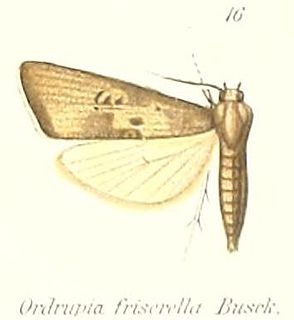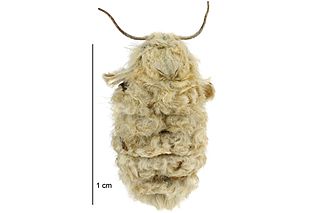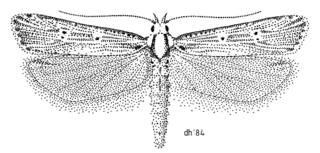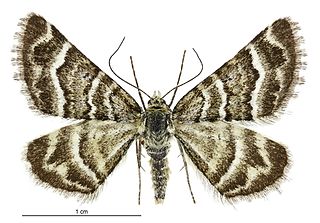
Copromorphidae, the "tropical fruitworm moths", is a family of insects in the lepidopteran order. These moths have broad, rounded forewings, and well-camouflaged scale patterns. Unlike Carposinidae the mouthparts include "labial palps" with the second rather than third segment the longest. With other unusual structural characteristics of the caterpillar and adult, it could represent the sister lineage of all other extant members of this superfamily. The genus Sisyroxena from Madagascar is also notable for its unusual venation and wing scale sockets.

Mnesarchaea is a genus of "New Zealand primitive moths" in the family Mnesarchaeidae. This genus is endemic to New Zealand.

Asaphodes is a genus of moths in the family Geometridae erected by Edward Meyrick in 1885. This genus is endemic to New Zealand and species within this genus are found throughout New Zealand including the North, South and Stewart / Rakiura Islands.

Paradetis is a monotypic moth genus in the family Geometridae. Its only species, Paradetis porphyrias, is endemic to New Zealand. The genus and species were first described by Edward Meyrick, the genus in 1885 and the species in 1883.

Austrocidaria parora is a species of moth of the family Geometridae. It is endemic to New Zealand.

Sabatinca chrysargyra is a species of moth belonging to the family Micropterigidae. It was described by Edward Meyrick in 1886 and is endemic to New Zealand. It can can be found from Franz Josef Glacier / Kā Roimata o Hine Hukatere south but only on the western side of the South Island. Adults are on the wing from the beginning of October until the middle of January. Larvae likely feed on foliose liverworts and have been found on species in the genus Plagiochila. The adult moths live in a range of habitats preferring sunny open spaces in forests or snow-tussock grasslands that can range in altitude from near sea level up to 1,230 m. This species is very similar in appearance to Sabatinca aemula and dissection of genitalia is required to distinguish between the two species.

Metacrias erichrysa is a species of moth of the family Erebidae. It is endemic to New Zealand. This species can be found in the lower half of the North Island and western alpine areas of the South Island. The adult female of the species is flightless and buff coloured whereas the male is brightly coloured and a rapid flier during daylight hours. The male of the species is on the wing from mid-November to early January. The species inhabits open herb and tussock fields in mountainous terrain at altitudes of between 900 and 1200 m. Larvae feed on Brachyglottis bellidioides,Festuca novae-zealandiae and indigenous species from the genera Acaena, Muehlenbeckia, Wahlenbergia and Raoulia.

Gracillariinae are a subfamily of moths which was described by Henry Tibbats Stainton in 1854.

Anisoplaca ptyoptera is a species of moth in the family Gelechiidae. It was described by Edward Meyrick in 1885 and is endemic to New Zealand. This species is found throughout the North and South Islands and prefers habitat where its host plants are common. The larval hosts of this moth are species in the genus Carmichaelia and the larvae stem mine the host plant. However larvae have also been observed feeding on gorse species and as a result their potential as a biological control for gorse has been researched. This behaviour has only been recorded in the Canterbury and Otago regions. A. ptyoptera overwinters as larvae and while in that life stage can be parasitised by species of wasp in the genera Zealachertus and Diadegma. Pupation begins in October. Adult moths are on the wing from October until May with peak emergence occurring in January. The adult moths come in two size classes and should the size of the female be in the larger class fecundity is improved. It is likely that this species has only one brood a year.

Aristotelia paradesma is a moth of the family Gelechiidae. It was described by Edward Meyrick in 1885 and is endemic to New Zealand. This species has been observed on both the North and South Islands. The larvae feed on Coprosma species creating and living in stem galls. The adults are on the wing from November to March and are attracted to light.

Thiotricha tetraphala is a species of moth in the family Gelechiidae. It was described by Edward Meyrick in 1885. It is endemic to New Zealand.

Asaphodes abrogata is a moth in the family Geometridae. It is endemic to New Zealand and can be found from the central North Island as well as the South Island. This species is inhabits open country at altitudes of between 2000 and 4000 ft. Larvae have been reared on Plantago species including Plantago coronopus. It has been recommended that Plantago raoulii be planted to attracted this species. Adults are on the wing in February and March.

Tingena is a genus of the concealer moth family (Oecophoridae). This genus is endemic to New Zealand.

Notoreas mechanitis is a species of moth in the family Geometridae. It is endemic to New Zealand.

Notoreas niphocrena is a species of moth in the family Geometridae. It is endemic to New Zealand.

Notoreas paradelpha is a species of moth in the family Geometridae. It is endemic to New Zealand.

Tingena maranta is a species of moth in the family Oecophoridae. It is endemic to New Zealand and is found in the lower South Island. Adults of this species are on the wing from October until January. This species perfers grass or low herb habitat. Unlike its close relatives it does not inhabit native forest.

Orthenches chlorocoma is a moth of the family Plutellidae first described by Edward Meyrick in 1885. It is endemic to New Zealand and has been observed in the North and South Islands.

Protosynaema eratopis is a species of moth in the family Plutellidae first described by Edward Meyrick in 1885. It is endemic to New Zealand.

Protosynaema quaestuosa is a species of moth in the family Plutellidae first described by Edward Meyrick in 1924. It is endemic to New Zealand.



















